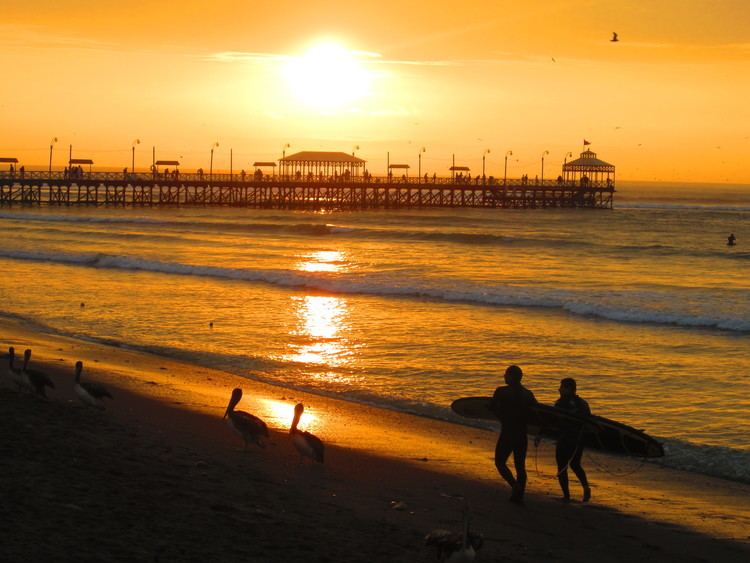District Huanchaco Time zone PET (UTC-5) | Region La Libertad Region Elevation 13 m (43 ft) Mayor Fernando Bazán Pinillos | |
 | ||
foundation Mochica in Pre-Columbian era timesSpanish: January 1, 1535 by fray Alonso de Escarcena and Juan de Barbaran. Similar Huaca del Sol, Plaza de Armas of Trujillo, El Brujo, Cathedral Basilica of St Mary, Huaca de la Luna | ||
Exploring huanchaco peru cool peruvian beach town
Huanchaco is a beachside town of Mochica origin and a popular vacation spot. It is the most visited beach of Trujillo in Peru. Situated 12 km northwest of the city in a bay, on a terrace at the foot of Campana mountain, Huanchaco is notable for its surf breaks and its caballitos de totora, and its ceviche. Huanchaco is near the ruin of Chan Chan. Huanchaco was approved as a World Surfing Reserve by the organization Save The Waves Coalition in 2012 This historic town is part of the tourist circuit called the "Moche Route" or "Ruta Moche". Today it is still a beautiful beach that, despite its modernity, still retains its old charm.
Contents
- Exploring huanchaco peru cool peruvian beach town
- Map of Huanchaco Peru
- Beach walk in huanchaco peru full version
- Pre Columbian era
- Colonial era
- Origin of ceviche
- Tourism
- Surfing
- Sandboarding
- Swamps of Huanchaco
- Festivals
- References
Map of Huanchaco, Peru
Beach walk in huanchaco peru full version
Pre-Columbian era
Huanchaco's original population were indigenous fishermen, who worshipped the moon and a golden fish called Huaca Taska
Some accounts suggest the name "Huanchaco" may originate from "Gua-Kocha, a Quechua word meaning "beautiful lake". It was the main port Moche, Chimú and Inca eras, and was described by Inca Garcilaso de la Vega as the preferred port of the Incas.
In the Chimú culture 800 A.C. to 1400 A.C. Huanchaco was the port for Chan Chan, which was established 4 km away
Colonial era
Following the Spanish conquest of 1534, the Spanish town was founded as "Huanchaco" on January 1, 1535 by the Franciscan friar Alonso of Escarcena and Juan de Barbaran.
In the colonial era, Huanchaco continued to be the main port of Trujillo city, but the port closed in 1870. Two decades later Victor Larco Herrera rebuilt the pier exclusively for exporting sugar from businesses in neighboring Chicama valley, one of the most important areas of sugar production in the country.
Origin of ceviche
According to Andrés Tinoco Rondan, an academic researcher at Ricardo Palma University, Huanchaco is the birthplace of ceviche. Oral histories suggest ceviche was prepared with lemons from Simbal (yunga village nearby), with chilli from the Moche River valley and seaweed extracted from the sea.
In Huanchaco the ceviche is often served to tourists with the seaweed called cochayuyo or mococho which are taken from the shores of Huanchaco
Tourism
Huanchaco is visited by tourists all over the world, particularly surfers. Several surf events are held and one of the most important each year in January is the Huanchaco longboard. Other nearby attractions include Chan Chan, Mount Campana, a sacred mountain in the Chimu culture and Pampas de Gramalote, a complex for shamanic experiences.
Surfing
In the year 2012 Huanchaco was approved as a World Surfing Reserve by the organization Save The Waves Coalition. This designation is the first awarded to a Latin America town and the fifth in the world. Huanchaco is notable not only for consistent, smooth waves, but also for being the birthplace of Caballito de totora boat which is regarded as one of the first known surf crafts
The Huanchaco Longboard World Championships is a surfing competition that has taken place since 2010 at the El Elio Beach in Huanchaco, and brings together leading surfers of several countries of the world.
Sandboarding
Many tourists enjoy sandboarding on dunes near the town of Laredo, outside of the city of Trujillo.
Swamps of Huanchaco
Swamps of Huanchaco, also known as Wetlands of Huanchaco is an ecological Chimu reserve located in Huanchaco Beach, about 14 km northwest of Trujillo city, Peru. From this ecological reserve the ancient mochica extracted the raw material for the manufacture of the ancient Caballitos de totora used since the time of the Moche for fishing. Currently Huanchaco fishermen still use materials from these swamps to make the traditional boats
